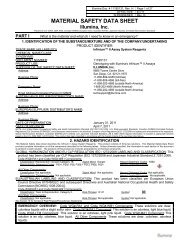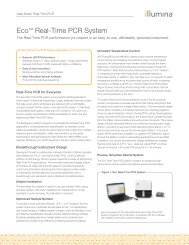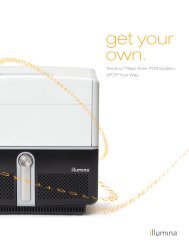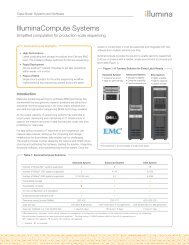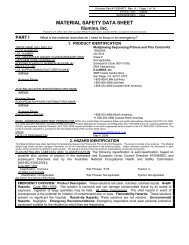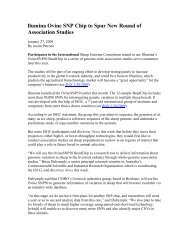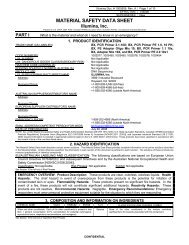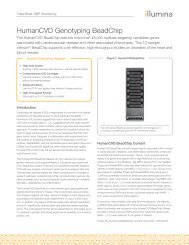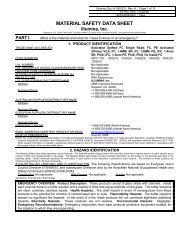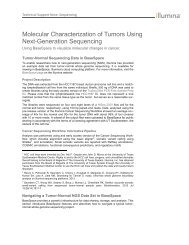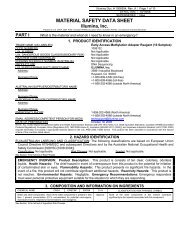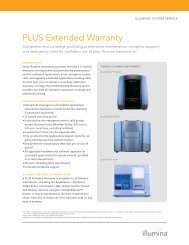MATERIAL SAFETY DATA SHEET - Illumina
MATERIAL SAFETY DATA SHEET - Illumina
MATERIAL SAFETY DATA SHEET - Illumina
Create successful ePaper yourself
Turn your PDF publications into a flip-book with our unique Google optimized e-Paper software.
TruSeq Enrichment Kit <strong>Illumina</strong> Doc. #15018476, Rev. A Page 13 of 17<br />
15. REGULATORY INFORMATION (Continued)<br />
ADDITIONAL U.S. REGULATIONS (continued):<br />
U.S. TSCA INVENTORY STATUS: This product is regulated by the Food and Drug Administration; it is exempt from<br />
the requirements of TSCA.<br />
OTHER U.S. FEDERAL REGULATIONS: Alkali Hydroxide is designated as a hazardous substance under Section<br />
311(b)(2)(A) of the Federal Water Pollution Control Act and further regulated by the Clean Water Act<br />
Amendments of 1977 and 1978. These regulations apply to discharges of Alkali Hydroxide.<br />
CALIFORNIA SAFE DRINKING WATER AND TOXIC ENFORCEMENT ACT (PROPOSITION 65): No constituent in<br />
the solutions of this product is on the California Proposition 65 lists.<br />
ANSI LABELING (Z129.1; Provided to Summarize Occupational Hazard Information):<br />
GA#-HP3: DANGER! CORROSIVE. CAUSES SKIN, EYE, AND DIGESTIVE TRACT BURNS. CAUSES RESPIRATORY<br />
TRACT IRRITATION. Do not taste or swallow. Do not get in eyes or on skin or clothing. Avoid breathing mist containing this<br />
product. Avoid prolonged or repeated skin contact. Keep container closed. Use only with adequate ventilation. Wash<br />
thoroughly after handling. Wear appropriate eye, hand, and body protection. Avoid exposure to elevated temperatures. FIRST-<br />
AID: In case of contact, immediately flush skin or eyes with plenty of water for at least 20 minutes while removing contaminated<br />
clothing and shoes. Get medical attention if irritation develops or persists. If inhaled, remove to fresh air. If not breathing, give<br />
artificial respiration. If breathing is difficult, give oxygen. If swallowed, do not induce vomiting. If victim is fully conscious, give a<br />
cupful of water. Never give by mouth to an unconscious person. Get medical attention immediately. Wash clothing before<br />
reuse. Destroy contaminated shoes. IN CASE OF FIRE: Use water fog, foam, dry chemical, or CO 2. IN CASE OF SPILL:<br />
Wipe up spilled liquid. Place residual in appropriate container and seal. Consult Material Safety Data Sheet for additional<br />
information.<br />
TC#-CT1, TC#-SMB, and TC#-WS1: CAUTION! POSSIBLE BIRTH DEFECT HAZARD. MAY CAUSE BIRTH DEFECTS<br />
BASED ON ANIMAL <strong>DATA</strong>. MAY CAUSE SKIN AND EYE IRRITATION. MAY CAUSE DISCOMFORT IF SWALLOWED OR<br />
INHALED. Do not taste or swallow. Avoid skin or eye contact. Avoid prolonged or repeated skin contact. Avoid breathing<br />
mists or sprays. Keep container closed. Use only with adequate ventilation. Wash thoroughly after handling. Wear gloves and<br />
goggles. FIRST-AID: In case of contact, immediately flush skin or eyes with plenty of water. If inhaled, remove to fresh air. If<br />
ingested, do not induce vomiting. Get medical attention if necessary. IN CASE OF FIRE: Use water fog, dry chemical, CO 2, or<br />
“alcohol” foam. IN CASE OF SPILL: Absorb spill with polypads and place in suitable container. Consult Material Safety Data<br />
Sheet for additional information.<br />
ANSI LABELING (Z129.1; Provided to Summarize Occupational Hazard Information) [continued]:<br />
All Other Solutions: CAUTION! MAY CAUSE SKIN AND EYE IRRITATION. MAY CAUSE DISCOMFORT IF SWALLOWED OR<br />
INHALED. Do not taste or swallow. Avoid skin or eye contact. Avoid prolonged or repeated skin contact. Avoid breathing<br />
mists or sprays. Keep container closed. Use only with adequate ventilation. Wash thoroughly after handling. Wear gloves and<br />
goggles. FIRST-AID: In case of contact, immediately flush skin or eyes with plenty of water. If inhaled, remove to fresh air. If<br />
ingested, do not induce vomiting. Get medical attention if necessary. IN CASE OF FIRE: Use water fog, dry chemical, CO 2, or<br />
“alcohol” foam. IN CASE OF SPILL: Absorb spill with polypads and place in suitable container. Consult Material Safety Data<br />
Sheet for additional information.<br />
ADDITIONAL CANADIAN REGULATIONS:<br />
CANADIAN DSL/NDSL INVENTORY STATUS: The constituents in this product’s solutions are listed on the DSL<br />
Inventory or are exempt.<br />
CANADIAN ENVIRONMENTAL PROTECTION ACT (CEPA) PRIORITY SUBSTANCES LISTS: The constituents in<br />
this product’s solutions are not on the CEPA Priority Substances Lists.<br />
CANADIAN WHMIS CLASSIFICATION AND SYMBOLS:<br />
GA#-HP3: Class E Corrosive Material<br />
TC#-CT1, TC#-SMB, and TC#-WS1: D2A Teratogenicity and embryotoxicity<br />
All Other Solutions: Not applicable.<br />
ADDITIONAL EUROPEAN UNION REGULATIONS:<br />
LABELING AND CLASSIFICATION: The following classification is self-classification, based on possible skin contact<br />
of product in the workplace and European Union Council Directive 67/548/EEC and subsequent Directives.<br />
GA#-HP3:<br />
Classification: Corrosive.<br />
Risk Phrases: [R 35]: Causes severe burns.<br />
Safety Phrases: [S 1/2]: Keep locked up and out of the reach of children. [S 26]: In case of contact with eyes, rinse<br />
immediately with plenty of water and seek medical advice. [S 37/39]: Wear suitable gloves and eye/face protection. [S 45]:<br />
In case of accident or if you feel unwell, seek medical advice immediately (show the label where possible).<br />
Hazard Symbol:



